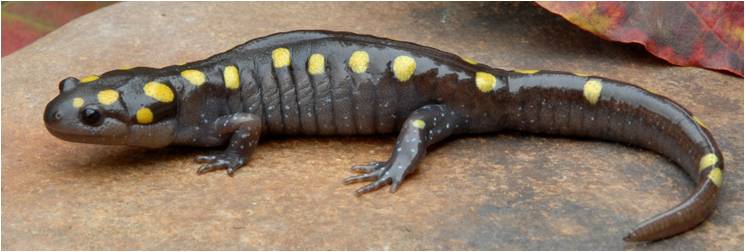Reproduction
During rains of March and early April, the
spotted salamander is spurred to migrate to its breeding pond.
These ponds are usually vernal pools or small ponds, deep enough
to not dry out over the summer and small enough not to house
many predators. Each salamander will return to the same pond
year after year to reproduce.


Courtship, which almost always occurs at night, is conducted as a group affair. The male salamanders will swim about in the shallow waters of their breeding pools nudging other salamanders with their snouts. Once he finds a female he rubs his chin on her head and deposits a spermatophore (packet of sperm). If the female follows the male, she will contact the spermatophore and deposit her eggs, fertilizing them in the process. Spotted salamander egg masses are fairly unique due to their large fist size and fairly gelatinous texture. If picked up the egg mass will usually stick together rather than fall apart like many of their amphibian relatives'. A female salamander can lay up to 250 eggs at a time, either in one large mass or several smaller ones. Each submerged mass has a gelatinous covering and is usually attached to the substrate. The masses will appear greenish due to the presense of green algae in the egg membranes.


Three to five weeks later the eggs hatch into small brownish larvae about half an inch long. They live the next three to four months in their catching pools, feeding mainly on insects and other small larvae while moving through their metamorphosis stage. It can take anywhere from three to four months, depending on the food supply, for the larvae to complete the transitions to adults. However, it takes several years before they become mature enough for reproduction.
Continue on to the
Interactions Page
Go Back to
Home
